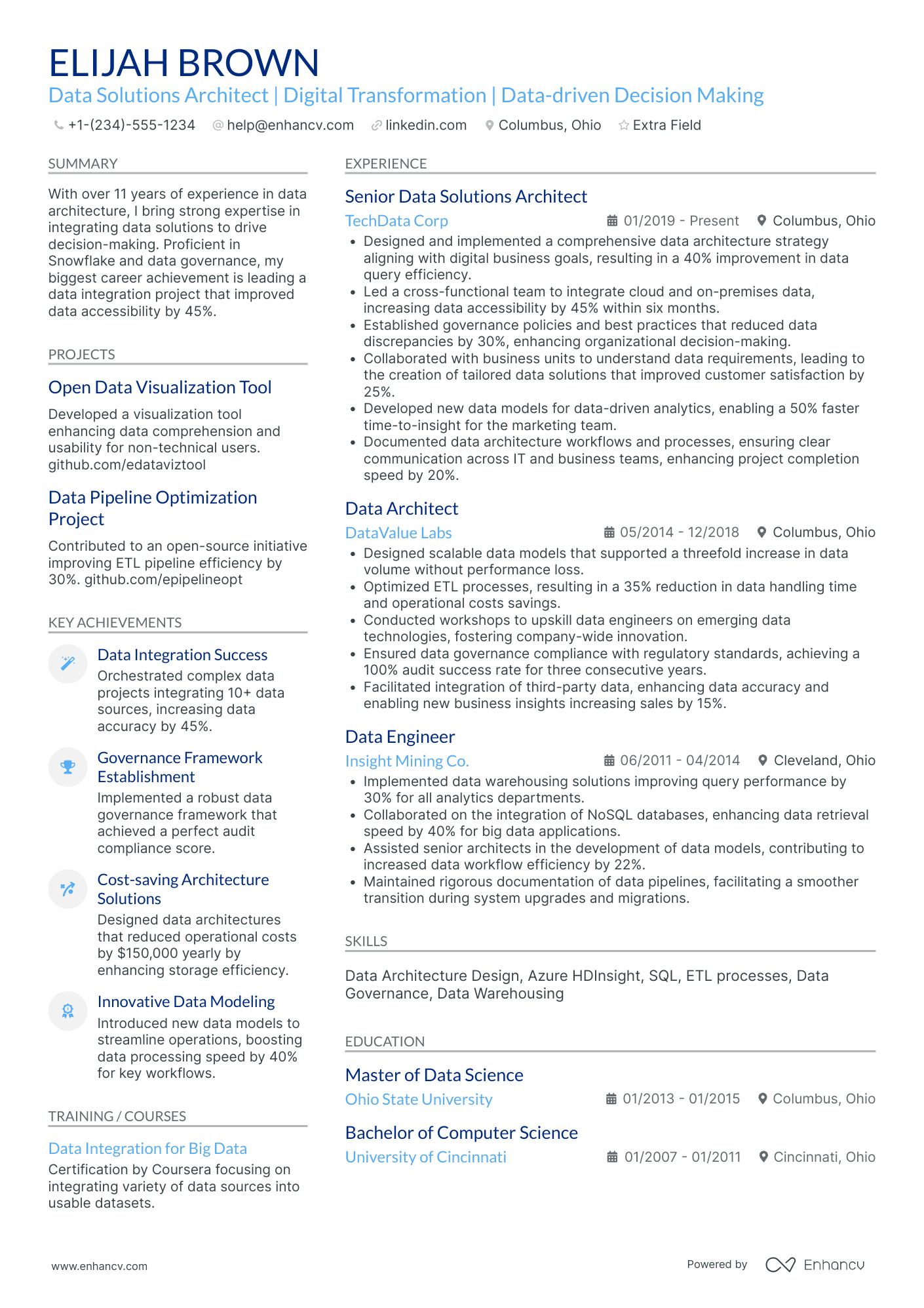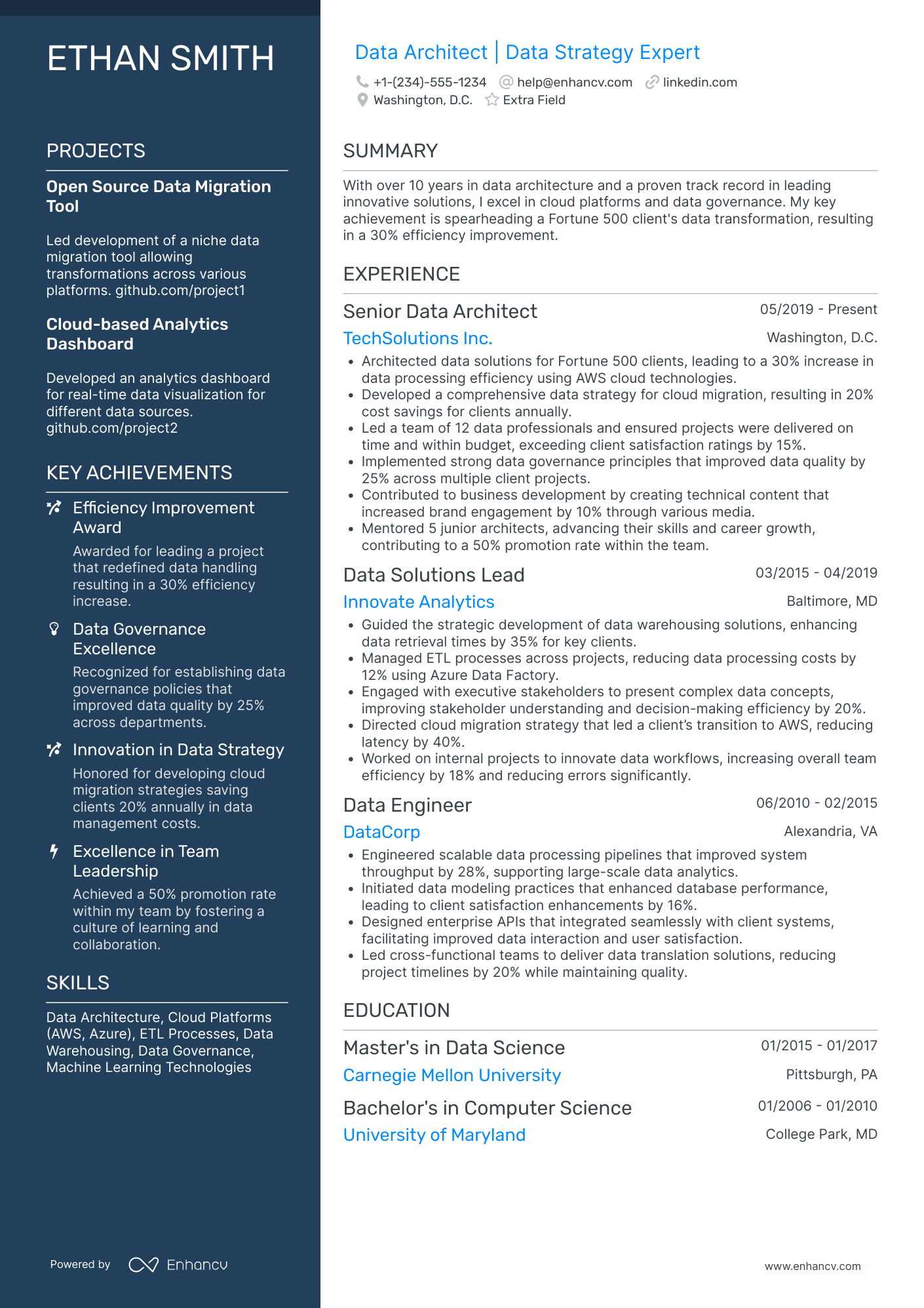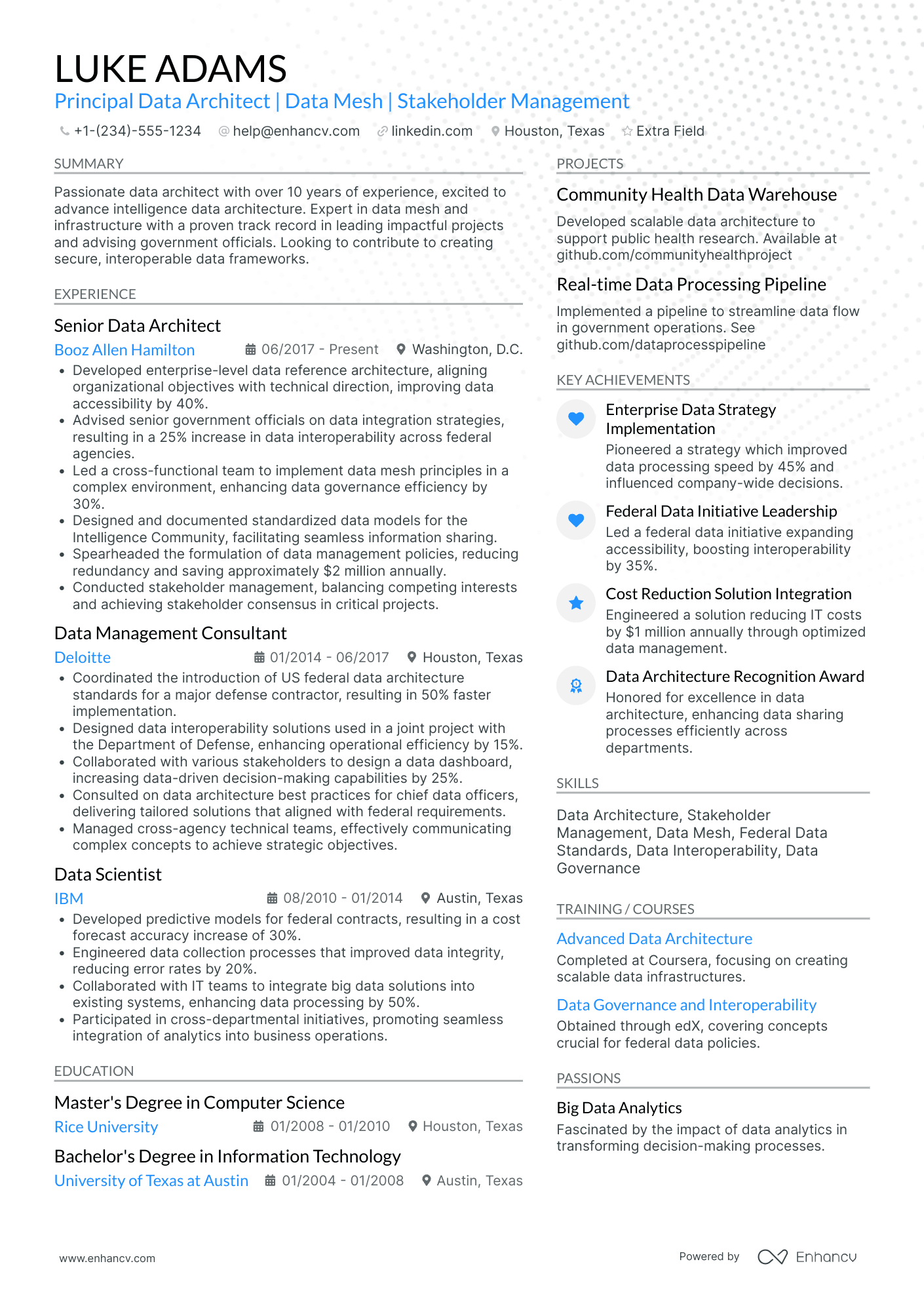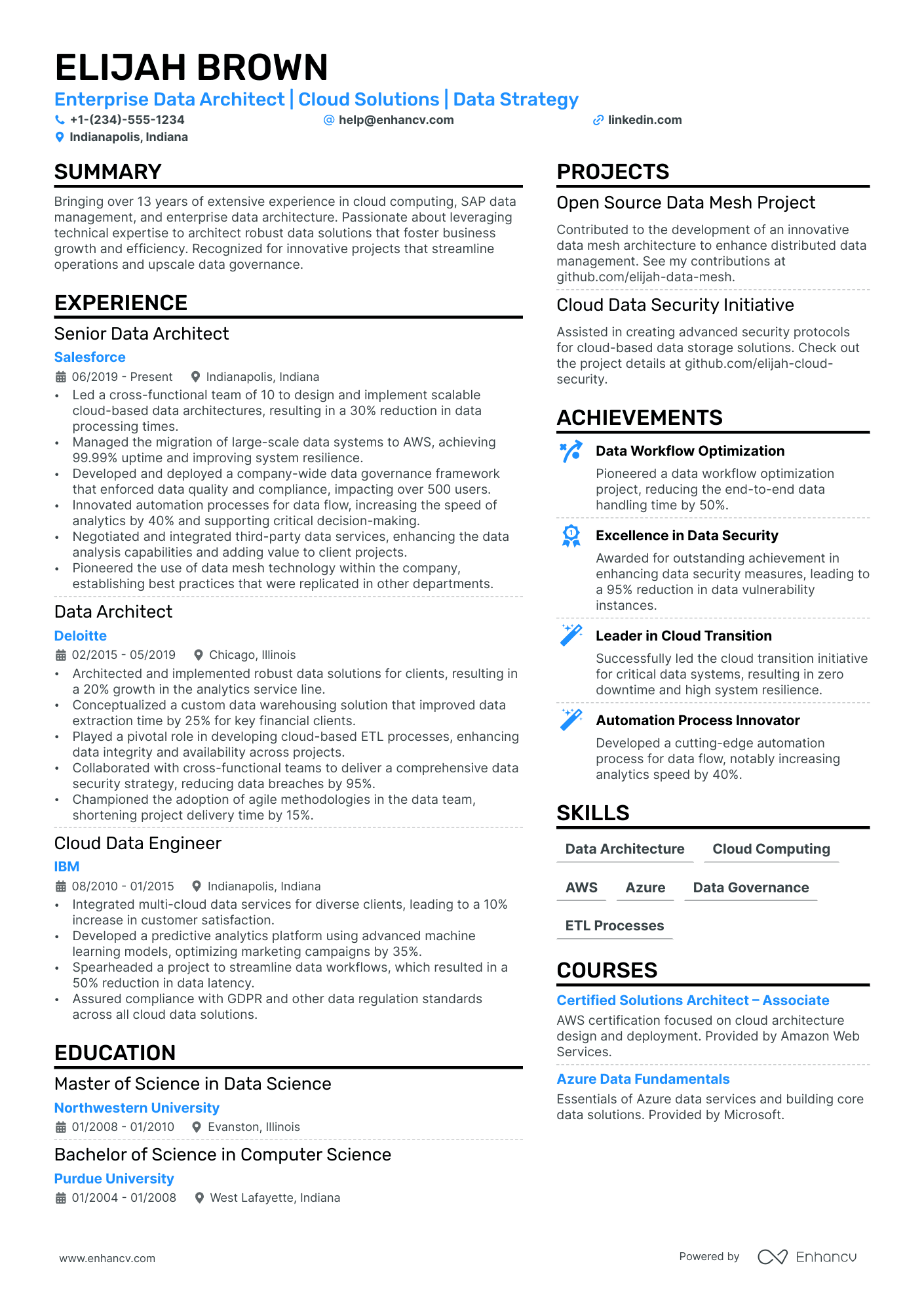Data architects who are looking for a new career opportunity will face a number of hurdles when updating their resume. In a high-demand industry, it can be easy to get lost in the shuffle of 200+ resumes that HR staff commonly go through to fill a single position.
How can you create a data architect resume that gets you noticed and avoids some of the common resume mistakes that data architects make? By following the steps in this guide that show you how to:
- Highlight experience in specific technologies and programming languages, like SQL, Java, and Python, that match the required skills listed in the job post.
- Demonstrate complex projects and data analyses using the right amount of technical jargon without being overly technical.
- Detail technical, business, and interpersonal skills that are essential for all data architects.
- Quantify work experience in a way that showcases your accomplishments in improving data performance, optimizing data access, and ensuring data security.
We’ll use real-world resume examples to show you the best way to create a detailed and concise resume that demonstrates your technical and personal skills using the proper format.
Before we get started, if this guide does not match your career plans, check out these resume examples for similar roles:
Data Architect resume examples
By Experience
By Role
Before adding your relevant skills, experience, and education, you first need to format your resume based on industry standards.
How to Format a Data Architect Resume
Knowing how to format your resume properly is essential to scoring well with applicant tracking systems and getting your resume seen by the right people.
While you can start with a pre-formatted resume template, it’s good to know what the standard resume format settings are:
- One-inch margins on all sides and single-line spacing so your resume is nicely balanced.
- A simple white background and black colored serif or sans-serif fonts so that your resume is easy to read.
- Individually formatted resume sections to separate your data for better readability.
- A font size between 10-12 points so you can fit as much data on a single page without making the text too small to read.
A quick word about font choices. Avoid any decorate or script fonts as they are harder to read. Classic fonts, like Times New Roman and Arial are still acceptable if not a little overused and outdated. There are more modern fonts available, like Exo 2, Lato, Montserrat, Raleway, Rubix, and Volkhov that you can choose.
Take a minute to read a little more about the different types of fonts that you can use on your resume.
These settings are standard in all resume templates, so you don’t need to worry about the technical details of formatting your resume. What you will need to decide on is the design and layout of your resume.
For careers that are heavily technical, one of the best resume templates to use is a modern resume template. This layout has a clean and efficient look with features graphics and icons, QR codes, and embedded videos. It takes into consideration that most resumes are read on a computer screen.
There are other template styles you can choose from, and they all come with their own unique benefits:
- Traditional: This single-column layout is one of the more commonly used resume templates and gives your resume a classic, conservative look. It uses a simple, clean background with no graphics, colors, or other modern features.
- Simple: This template gives your resume a minimalistic look and presents your information in a clean and concise layout. Best for those who want to present their skills and experience in a simple and direct fashion.
- Creative: For those who want to show off their individuality and creativity. This format uses a two-column layout with colored backgrounds and visually appealing graphics that can really make your resume stand out.
Different markets have specific resume styles – a Canadian resume, for instance, may require a different approach.
If you have your data architect resume ready to go, run it through our resume checker for a free analysis.
Is your resume good enough?
Drop your resume here or choose a file. PDF & DOCX only. Max 2MB file size.
A well-formatted resume includes a number of required sections that give HR teams a better sense of your capabilities.
The top sections on a data architect resume:
- Professional statement: A brief description of your career that illustrates your years of experience, focusing on key data architect metrics that give the reader a clear indication of why they should hire you.
- Technical skills: Using multiple resume sections, detail experience in relevant hard skills, like data modeling and design, database management, system architecture, data security, and other necessary technical skills.
- Work experience: A detailed list of relevant work experience using a chronological format that focuses on relevant experience over the order of employment. This format is preferred for experienced data architects with several years of experience.
- Relevant projects: You can further demonstrate your experience by detailing various data architecture projects at past companies or personal or volunteer projects. These can include advising and implementing cloud-based data designs, scaling large enterprise data solutions, improving data security, and other data-focused projects.
- Education and certifications: No matter how many years of experience you have, you need to show a strong educational background that includes a bachelor’s or master’s degree, technical certifications, and continuing education courses.
To create a job-getting data architect resume, focus on the following strengths and abilities.
What recruiters want to see on your resume:
- Strong technical abilities: Hiring teams want to see a strong technical background with experience in a wide range of skills, like data integration and ETL, proficiencies in SQL, MySQL, Oracle, and other database management tools, and multiple programming languages.
- Project management skills: A skilled data architect will need to demonstrate their ability to handle multiple projects, which include prioritizing different projects and working with technical and non-technical staff to ensure all projects are fully tested and completed on time.
- Knowledge of data privacy and security regulations: Security and privacy are primary concerns for everyone, and recruiters like to see actionable results in your ability to secure data and protect your customer's information.
- Problem-solving abilities: Complex data structures require complex solutions to ensure security and minimize downtime. This calls for creative, out-of-the-box thinking to stay ahead of probing eyes and ever-changing security threats.
- Relevant certifications: Many positions will require advanced training in relevant technologies, like Certified Data Management Professional (CDMP), AWS Certified Solutions Architect, or an Oracle Certified Master.
A few final words on formatting the resume experience and education section. Each one has an additional formatting requirement. In the education section, you will list each degree in reverse chronological order. Your first entry will be the most recently completed degree.
For the resume experience section, you can list your experience in two ways:
- Chronological order: This format focuses more on relevant skills than a career timeline. It is best for tech-heavy positions and those who have a lot of temp or contract data architect jobs, which are more popular and sometimes more profitable these days than the traditional 9-5 job.
- Reverse chronological order: As with your education section, you will list your past work experience, starting with the most recent experience and working backward from there. This format is best for those with only a few years of experience or who have multiple jobs using the same technologies and responsibilities.
Other formats include functional skills-based, which emphasizes your technical skills like big data analysis, designing more robust data architectures, and improving real-time data processing times. The hybrid/combo format takes the best of each format and combines it. Data architects with less than 3 years of experience and who want equal emphasis on their skills can use this format.
Lastly, when you are ready to send out your resume, save it as a PDF document (.pdf). This is the standard format for all resumes. It will preserve the look and feel of your resume and is easily accessible on all operating systems and devices.
How to Write Your Data Architect Resume Experience Section
The main purpose of your resume is to detail your past work experience as a data architect or those positions where you did the work of a data architect. The resume experience section will include part- and full-time employment, freelance data architect work, and any volunteer work where you improved a company’s data infrastructure.
This section will include a list of up to three jobs that detail your relevant work experience. Each entry needs to include:
- Job title
- Company name and location
- Industry type or brief
- Dates of employment, including currently held positions
- 3-5 bullet points that detail your duties and responsibilities
Keep in mind that when you are filling out this section, a common mistake is simply listing the duties you performed without showing how your work improved the company's data infrastructure. Our goal is to help you avoid doing this.
Take a look at this first example from a real-world data architect resume experience section:
- •Designed and implemented a data architecture framework that enabled data-driven decision-making.
- •Developed an ETL process for transforming and loading data into a data warehouse
- •Developed a data governance strategy to ensure consistency and accuracy of all data.
- •Created data charts for reporting, analytics, and decision support.
After reading this example, do you get a good impression of how well they will perform the duties of a data architect? Not really.
There is nothing to indicate how well the framework they designed or the ETL processes they implemented performed. It also does little to show how their data analysis improved backend performance. This example leaves you with more questions than answers and is something recruiters see every day.
Fortunately, there is an easy solution to this common problem. Take a look at our example after we add some relevant details.
- •Designed and implemented a real-time, relational data architecture framework for a law firm that enabled data-driven decision-making, creating a 43% increase in data efficiency.
- •Developed an ETL process for transforming and loading data into a data warehouse from 15 different law offices nationwide, resulting in a 28% faster data throughput.
- •Developed a data governance strategy to ensure consistency and accuracy of all data, leading to a 78% reduction in data errors.
- •Implemented new monitoring tools using Redgate SQL monitor, causing a 60% increase in detecting problems and alerting technicians before it affects users.
Now, we have a better idea of this person’s abilities and accomplishments in improving the company's database. With this example, we have a more accurate description of:
- Their ability to design and implement a relational database.
- The type of industry they have experience in.
- The effects their actions had on the data infrastructure.
- Their knowledge of federal and local regulations and their attempts at being compliant.
- Their ability to analyze data and make improvements based on what they read.
If you are unsure which metrics you can quantify, we’ll show you a few examples of the kinds of data architect metrics you can quantify.
How to quantify impact on your resume
One of the biggest complaints from hiring staff is getting resumes that don’t accurately show the potential of new recruits. Instead of getting resumes that use numbers and percentages to show actionable results, they get a re-telling of the job duties and responsibilities, just like our first example.
Recruiters already know what the job duties and responsibilities are. After all, they’re the ones who created the job post in the first place.
What they want to see are the results of your actions. How did your new database design improve efficiency or reduce downtime? How were your customers impacted by your data-hardening techniques? What was the outcome of any cross-functional teams you led or worked in?
Check out these real-world examples of quantifying the impact of your data architect resume:
- Number of data systems designed and implemented: “Supervised the design and development of 12 new AWS data warehouses to support BI initiatives, which led to a $5M annual revenue increase.”
- Number of business processes improved: “Developed 25 reports using Tableau Desktop and SQL queries, which increased visibility in the status of the sales pipeline by 78%.”
- Size and scale of data managed: “Managed a 100GB MySQL database with over 50 million rows, achieving 99.99% uptime and 5ms average query response time.”
- Number of cross-functional team collaborations: “Collaborated with cross-functional teams to define and document system requirements, resulting in a 30% increase in project success rate and a 20% reduction in project delivery time.”
- Increases in data accessibility or usability: “Generated 75% performance gain for enterprise BI systems by strengthening OLAP database systems.
- Reductions in downtime: “Developed solution architecture for CRM capability of the company, decreasing delays in data by 80% and boosting data availability by 100%.”
- Value of cost savings initiatives: “Designed and implemented a scalable data lake and data warehouse architecture for a global retailer, resulting in a 50% reduction in data storage costs.”
- Success rates of projects led: “Conceived a new monitoring system that tracked the performance rating of 3,400 staff, increasing productivity among 11 top sales performers.”
One of the easiest ways to create a tailored resume is by quantifying those metrics that are listed in the job post. If you are reading a job post that mentions team collaboration and data design as their main responsibilities, you’ll want to quantify those metrics.
Next, we’ll spend a little time talking about the kinds of experience first-time data architects can add to this section when looking for their first professional role.
How do I write a data architect resume with no experience
Landing your first data architect job can seem like a daunting task. A common mistake is including irrelevant jobs that don’t do anything to promote your skills in database design, analysis, and security.
What recruiters are interested in seeing from entry-level data architects are the jobs where you:
- Gained experience in programming languages, such as SQL, Python, or Java.
- Worked on managing relational databases through SQL Server, MongoDB, or MySQL.
- Managed various types of data storage systems.
- Used data modeling tools like Erwin Data Modeler, Lucidchart, or SQL Developer Data Modeler.
- Worked on big data technologies, such as Hadoop, Spark, or Kafka.
If you lack real-world work experience, you can showcase additional work experience through personal projects, volunteering, academic projects, and college internships.
Now it’s time to focus on adding those ever-important technical, business, and personal skills to further impress your future employer.
How to List Your Hard and Soft Skills on Your Resume
data architecture is a highly technical position but still requires more personal skills, like leadership, stress management, and coming up with creative solutions to complex problems. When updating your resume, you want to include all relevant hard and soft skills you are proficient in. What is the difference between hard and soft skills?
Hard skills are those necessary skills that you learn through school, continuing education courses, and on-the-job training. They include how to design and implement various types of data systems, knowledge of several types of programming languages, complex processes like ETL, state and federal regulatory compliance, and implementing distributed data systems.
Soft skills are those skills that make you a better leader and maintain a level head when dealing with difficult staff or customers. They include essential skills like expressing empathy, advanced problem-solving skills, active listening skills, and resilience. They help you come up with complex solutions and be more adaptable to different work environments.
Here are some of the top hard skills that recruiters like to see from potential recruits.
Best hard skills for your data architect resume
- SQL
- NoSQL
- Hadoop
- Apache Kafka
- Hive
- Spark
- ETL (extract, transform, load) Processes
- Python
- XML
- Data warehousing
- Data modeling
- Machine learning
- Database design
- Oracle
- Microsoft SQL Server
- Cloud technologies (AWS, Google Cloud, Azure)
- Tableau
- Big data analytics
- Apache Cassandra
- Data security and encryption
Data architects play an integral role in designing, implementing, and maintaining a company's data infrastructure in an ever-growing technical world. This requires a strong technical background in a wide range of hardware and software.
Enhancv technical section allows you to group various hard skills, like so:
In addition to your hard skills, you’ll need to include one or two sections to demonstrate the following soft skills.
Best soft skills for your data architect resume
- Communications
- Problem-solving
- Critical thinking
- Teamwork
- Leadership
- Adaptability
- Project management
- Attention to detail
- Time management
- Creativity
- Decision-making
- Strategic planning
- Stress management
- Negotiations
- Patience
- Empathy
- Active listening
- Persuasion
- Self-motivation
- Resilience
Enhancv offers a number of additional resume sections where you can list your soft skills, including our passion, strengths, and talent sections.
The next must-have section we’ll talk about is for your education and advanced training in specialized technologies and data architecture.
How to List Your Certifications and Education on Your Resume
The resume education section is imperative for all data architects, no matter how long ago you earned your degree. Doing this shows recruiters that you have a solid educational foundation and the skills and knowledge necessary for the job.
When listing your education, you’ll want to include:
- Degree type and major
- School name and location
- Dates of enrollment/graduation
- A bullet list of courses, academic projects, or relevant extra-curricular activities
You only need to include coursework if you just graduated or are still working on gaining real-world experience.
The certification section is where you will display any relevant technical certifications in cloud architecture, relational database design, data security, and other specialized training.
For each entry, you only need to include the certificate name and the institution that provided the training.
Here are some top certifications that can help improve your skills and increase your earning potential.
Best certifications for your data architect resume
In the next section, we’ll show you how you can further tailor your resume by writing a compelling resume summary or objective.
How to Write Your Data Architect Resume Summary Or Objective
One of the first things HR staff and hiring managers will read is your professional career statement. This section is where you’ll detail your past career or list your career objectives if you don’t have a lot of real-world experience to date.
What’s the difference between a resume summary and an objective? A resume summary is for those with more than five years of data architect experience and looking for a new job in a similar role or industry. It is a concise 3-5 sentence summary of their career and quantifies relevant metrics that relate to the job description.
A resume objective is for data architects just starting their careers and still looking to gain real-world experience. It lists their career objectives in 2-5 sentences and can include a plan of action to achieve their goals.
We will look at a professional data architect's resume summary to show you the best way to format this section. This first example is how the majority of data architects summarize their careers.
This example does an OK job of summarizing their career but is too vague and doesn’t really sell their abilities. You get a sense of what they are capable of but are still left with too many questions, like “How did you use your skills and knowledge to reduce infrastructure costs and improve system reliability?”
Your goal is to provide answers, not create more questions. Let’s try to improve this a little by adding some relevant details.
This example does an excellent job of detailing their abilities as well as quantifying multiple key data architect metrics. Notice how, with just a few more details, we get a better idea of:
- The number of years of experience as a data architect.
- The industry they have experience in.
- The results of their data design and implementations.
- Their ability to lead technical and non-technical team members to improve the company’s overall data performance.
Still have some space to fill on your resume? Consider adding a few more sections to demonstrate your skills.
Optimize your resume summary and objective for ATS
Drop your resume here or choose a file.
PDF & DOCX only. Max 2MB file size.
Additional Sections for a Data Architect Resume
One way to showcase more of your technical prowess and passion for working with data is by including additional resume sections to highlight relevant skills and information.
Here are some of Enhancv's customizable sections that are included with all of our resume templates:
- Professional associations: Showing your membership in local networking groups and national associations demonstrates your connection to the industry and your dedication to staying current with new technologies and hacking threats.
- Published works: data architects who publish articles, books, or technical documents can use this section to highlight their expertise.
- Awards and recognitions: This section allows you to highlight your accomplishments and recognitions.
- Continuing education: Technology fields are always changing, and you want to demonstrate your passion for learning through weekend workshops, seminars, conferences, and continuing education courses.
Adding relevant projects to your data architect resume
As an experienced data architect, you have worked on multiple projects that can demonstrate your skills and experience.
Project portfolios allow you to detail:
- Database design projects
- Data integration and ETL projects
- Data warehouse/lake projects
- Data quality and governance projects
- Big data projects
- Cloud data architecture projects
Plus, designing your own website is another way to demonstrate your design and coding skills.
The best place to add a link to a project portfolio is in the header.
Check out these sites if you want to build a project portfolio:
Key Takeaways
You did it! You now have a professionally formatted data architect resume that will greatly increase your chances of getting an interview. Throughout this guide, we discussed several ways to improve your resume and how to make a good first impression by:
- Quantifying your work experience based on keywords and technologies listed in the job post.
- Detailing required and relevant technical and interpersonal skills in the resume experience, summary, and other technical resume sections.
- Highlighting advanced training through certifications, tech seminars, and continuing education courses.
- Having a project portfolio to demonstrate all of your technical skills, published works, awards and accomplishments, and training programs created.


























